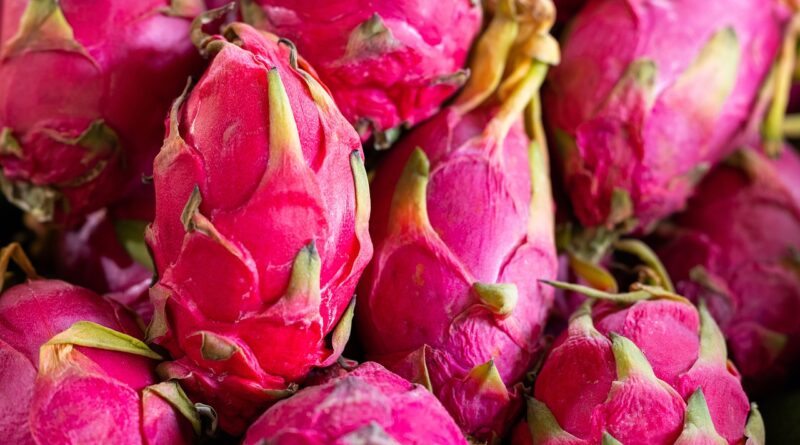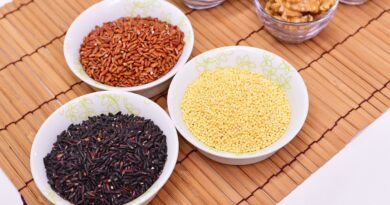Dragon Fruit Colors, Health Benefits, and Nutritional Value of This Exotic Superfood
Dragon fruit, also known as pitaya, is a strikingly vibrant fruit native to Central America but now cultivated and enjoyed worldwide. Known for its exotic appearance and nutritional benefits, dragon fruit comes in different varieties, each distinguished by its unique color and subtly sweet flavor. Inside, the flesh can range from white to deep red, with tiny black seeds speckled throughout, offering a delightful crunch.
Dragon Fruit Varieties and Inside Colors
There are four main varieties of dragon fruit, each with a distinct color and slightly different taste profile:
1. White Flesh Dragon Fruit (Hylocereus undatus)
Description: This is the most common type of dragon fruit, featuring bright pink or yellow skin with white flesh inside and tiny black seeds. It has a mild flavor with a light sweetness.
Availability: Widely available and often the least expensive variety.
2. Red Flesh Dragon Fruit (Hylocereus costaricensis)
Description: Known for its deep red or magenta flesh, this variety has a richer flavor than the white-fleshed type. Its outer skin is usually pink or red, adding to its visual appeal.
Taste Profile: Slightly sweeter and bolder than the white flesh variety, making it popular for desserts and smoothies.
3. Yellow Skin Dragon Fruit (Selenicereus megalanthus)
Description: Characterized by its bright yellow skin and white flesh, this variety is smaller in size but offers a distinctive, sweet taste.
Taste Profile: This is often considered the sweetest variety and has a more tropical flavor, making it ideal for those new to dragon fruit.
4. Purple Flesh Dragon Fruit
Description: Less commonly found, this variety has a dark purple flesh and a flavor similar to the red variety but with a unique twist. It is highly pigmented, lending a vibrant color to juices and smoothies.
Taste Profile: Sweet and juicy with a slightly tart undertone.
Nutritional Profile of Dragon Fruit
Dragon fruit is packed with vital nutrients that contribute to overall health and wellness. Regardless of the color, each type provides a variety of vitamins, minerals, antioxidants, and other beneficial compounds.
Vitamins: High in Vitamin C, Vitamin B1 (thiamine), Vitamin B2 (riboflavin), and Vitamin B3 (niacin).
Minerals: Contains calcium, iron, phosphorus, and magnesium.
Fiber: Excellent source of dietary fiber, aiding in digestion.
Antioxidants: Rich in betacyanins (red and purple varieties) and polyphenols, which help protect cells from damage and reduce inflammation.
Healthy Fats: Contains beneficial fats from the tiny black seeds, contributing to heart health.
Health Benefits of Dragon Fruit
1. Boosts Immunity
Vitamin C Richness: Dragon fruit is high in Vitamin C, a powerful antioxidant that supports immune function. Vitamin C helps white blood cells perform more effectively, protecting the body against infections and diseases.
Antioxidants: The high levels of antioxidants in red and purple dragon fruit, especially betacyanins, reduce oxidative stress and inflammation, further boosting immunity.
Essential Fruits and Vegetables to Eat During Winter in India for Optimal Health
2. Improves Digestion
High Fiber Content: Dragon fruit’s rich fiber content aids in digestion by promoting healthy bowel movements and preventing constipation.
Prebiotics for Gut Health: The fruit contains natural prebiotics that nourish beneficial gut bacteria, improving gut health and aiding digestion. Studies suggest that prebiotics may help reduce symptoms of digestive issues like irritable bowel syndrome (IBS).
3. Aids in Weight Management
Low Calorie and High Fiber: Being low in calories yet high in fiber, dragon fruit helps keep you feeling full for longer, which can prevent overeating and aid in weight management.
Hydrating Properties: Dragon fruit has a high water content, which helps keep the body hydrated and may reduce unnecessary snacking.
4. Promotes Skin Health
Rich in Antioxidants: The Vitamin C and betacyanin in dragon fruit fight free radicals, reducing signs of aging like wrinkles and fine lines. Consuming dragon fruit or applying it as a mask can help brighten the skin.
Healing Properties: The fruit’s anti-inflammatory properties help heal sunburns and skin irritation. Mixing dragon fruit with honey can create a soothing face mask for glowing skin.
5. Supports Cardiovascular Health
Heart-Healthy Fats: The seeds in dragon fruit contain essential fatty acids such as omega-3 and omega-6, which help lower bad cholesterol (LDL) levels and improve heart health.
Antioxidants for Heart Health: The antioxidants in dragon fruit reduce oxidative stress and inflammation, factors linked to heart disease.
6. Improves Bone Health
Calcium and Magnesium: Dragon fruit contains both calcium and magnesium, essential for maintaining strong bones and preventing osteoporosis.
Promotes Muscle Health: Magnesium also supports muscle relaxation and function, making dragon fruit an excellent post-workout snack.
7. Enhances Iron Absorption
Iron Content: Iron is essential for oxygen transport in the body, and dragon fruit provides a healthy dose of this mineral.
Vitamin C Synergy: The Vitamin C in dragon fruit enhances iron absorption, making it a beneficial food for individuals with low iron levels or anemia.
8. May Have Anti-Cancer Properties
High in Polyphenols: Dragon fruit’s high polyphenol content may contribute to cancer prevention by neutralizing free radicals and reducing oxidative stress.
Betacyanin Benefits: The deep red and purple varieties are especially rich in betacyanins, which have been linked to reducing the risk of certain cancers, although more research is needed to confirm these benefits.
How to Include Dragon Fruit in Your Diet
There are many ways to incorporate dragon fruit into your daily diet:
Smoothies and Juices: Add it to smoothies for natural sweetness and a vibrant color. It pairs well with berries, bananas, and tropical fruits like mango.
Salads: Dice dragon fruit and add it to fruit or green salads for an exotic twist.
Desserts: Use it as a base for sorbets, popsicles, or even fruit salads with a touch of lime and honey.
Breakfast Bowls: Add cubed dragon fruit to yogurt, chia pudding, or oatmeal for a colorful, nutritious boost.
Face Masks: For a natural face mask, mash a small amount of dragon fruit, mix with honey, and apply it to the skin for a glowing effect.
Potential Side Effects and Precautions
While dragon fruit is safe for most people, some individuals may experience mild allergic reactions, including:
Mild Allergic Reactions: Rarely, some people may experience swelling or itching in the mouth after consuming dragon fruit. If this occurs, it’s advisable to discontinue use.
Diarrhea: Due to its high fiber content, consuming large amounts of dragon fruit can lead to digestive issues like bloating or diarrhea in some people.
Coloration of Urine and Feces: Eating red or purple varieties may cause temporary discoloration of urine and stool due to the pigments, which is harmless.
Conclusion
Dragon fruit is a visually captivating and nutritionally dense fruit with numerous health benefits, from supporting immunity and digestion to enhancing skin and heart health. With varieties offering a range of colors and flavors, this superfood fits well into many diets, providing a wealth of essential vitamins, minerals, and antioxidants. Affordable, versatile, and easy to incorporate into your daily meals, dragon fruit is not only a delight to the senses but a fantastic addition to a balanced, healthy lifestyle.




